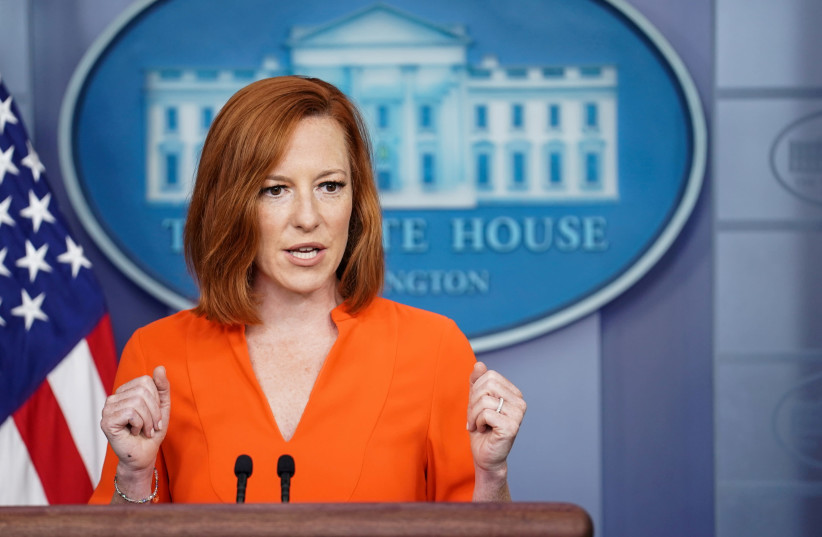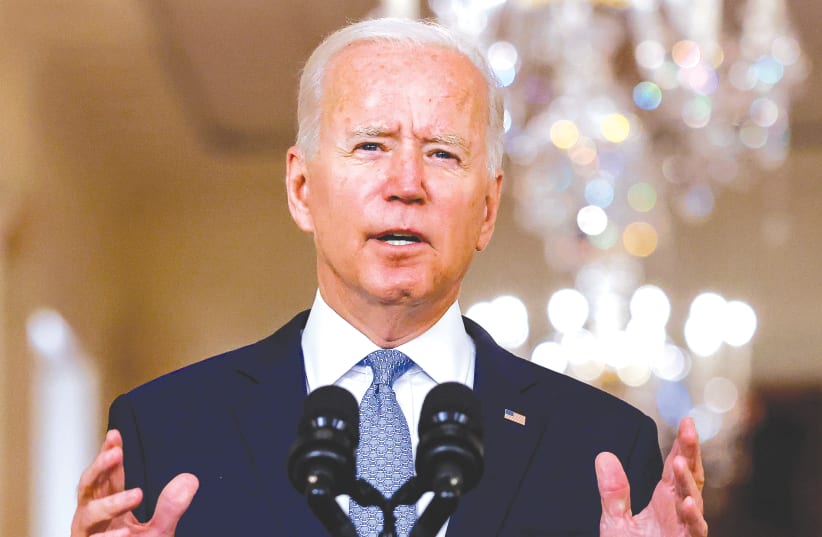When asked how the indirect negotiations between the US and Iran to restore the 2015 Joint Comprehensive Plan of Action nuclear deal were going, White House Press Secretary Jen Psaki avoided answering the actual question, and instead launched into a revisionist history lesson blaming former president Donald Trump for Iran’s aggression.
There are many good-faith criticisms of Trump’s decision to be made, but many of the things Psaki said were simply false.
Plus, the fact that the White House messaging is focused on assigning blame is a harbinger of bad news from the talks in Vienna.
“None of the things we’re looking at now – Iran’s increased capability and capacity, their aggressive actions that they have taken through proxy wars around the world – would be happening if the former president had not recklessly pulled out of the nuclear deal with no thought as to what might come next,” Psaki said.
Just to give a couple of very basic examples of why that’s factually incorrect: Hezbollah was founded in 1985, with funds and training by Iran’s Islamic Revolutionary Guard Corps. More recently, in 2014, during the tenure of Trump’s predecessor Barack Obama, Iran proxy Houthis launched the civil war in Yemen.
Psaki also argued, “Because of the last administration pulling out of the nuclear agreement... Iran directly attacked our partners in the Gulf.”


In fact, in 2015, Iran set up a bomb factory and weapons caches in Bahrain, where it was planning terrorist attacks. The following year, the Philippines foiled an Iranian plan to hijack a Saudi plane. The following year, the Houthis attacked Saudi and Emirati ships, as well as Riyadh International Airport and a Saudi palace. Their attacks on Saudi Arabia continued in 2018. So, no, attacks on US partners in the Gulf are not a result of Trump leaving the Iran deal.
In fact, the JCPOA, in lifting sanctions on Iran, freed up more funds for Iran to funnel to its proxies. The regime increased its support for the Houthis and Syrian leader Bashar Assad in 2015, for example.
In the years that the JCPOA was in place, Iran also tested ballistic missiles, seized US sailors, harassed US Navy ships dozens of times, attacked a US ship, and fired rockets at the Golan and more.
Psaki further noted, “The fact that the former president ripped up the nuclear deal meant that Iran’s nuclear program was no longer in a box, it no longer had the most robust inspection regime ever negotiated, no longer had the tight restrictions on nuclear activity.... Because of the last administration pulling out of the nuclear agreement, now Iran’s program has been rapidly accelerating.”
State Department spokesperson Ned Price’s Trump deflection was somewhat better conceived than Psaki’s.
“It’s worth spending just a moment on how we got here,” Price said. “It is deeply unfortunate that because of an ill-considered or perhaps unconsidered decision by the previous administration that this administration came into office without these stringent verification and monitoring protocols that were in place.”
IT IS TRUE that Iran did not enrich uranium beyond what was permitted in the JCPOA until after Trump abandoned the deal, and once it fell apart, the monitoring mechanisms did, as well.
It is also true that the monitoring was not that great in the first place. Iran was lying, and continues to lie, about the nature of its nuclear program, as proven by the nuclear archive smuggled into Israel by the Mossad shortly before Trump withdrew from the JCPOA.
Also, it’s worth noting that the JCPOA to which the Biden administration seeks to return – and has abandoned trying to make “longer and stronger” – would permit all of the steps that Iran has taken in its nuclear program in recent years after 2030.
The JCPOA only deferred the nuclear problem, it didn’t solve it, while exacerbating the proxies and ballistic missile problems.
Leaving the fact check aside, the White House’s blame game is still a bad sign for the nuclear talks.
The Biden administration has always blamed the Trump administration for Iran’s current brazenness, but that wasn’t its central message. Rather, they were focused on restoring the JCPOA.
Now, the plan is to “focus the fire on Trump,” as an administration source told Axios, in order to distract from how bad the Vienna talks are going.
Those negotiations are moving at a glacial pace.
On the technical level, the Iranian delegation refuses to speak directly to the Americans, requiring the other parties – Russia, China, and the E3, which are France, Germany and the UK – to shuttle between them, slowing down the process.
On the practical level, Iran has not shown much flexibility. A New York Times article this week claimed, “Iranian negotiators under Mr. [Ebrahim] Raisi, the new president – who had criticized his predecessor, Hassan Rouhani, for being too soft – made an important concession... by agreeing to work from a draft agreement worked out with Mr. Rouhani’s team.”
In other words, the only “concession” Iran was willing to make was not really a concession at all. It was to pick up where the talks left off. Meanwhile, Iran is seeking guarantees that US President Joe Biden can’t legally give: that the next president will maintain his policy, and some kind of promise that they will see economic benefits after sanctions are lifted.
The Western parties to the talks insist they will soon reach the point at which Iran will have to take some bigger steps toward returning to the JCPOA or they will walk away from the table. Some have said that point will be in late January or early February.
Neither result will look good for the Biden administration. Either they won’t return to the JCPOA, a foreign policy goal Biden already set during his presidential campaign, and the diplomacy he so touted will have failed. Or they will succeed on that front, but all of the aforementioned proven weaknesses of the nuclear deal will still be in place.
To get ahead of the anticipated backlash when all the options are bad, the Biden administration is blaming Trump. Whether people will buy that message over a year after Biden entered office remains to be seen.
